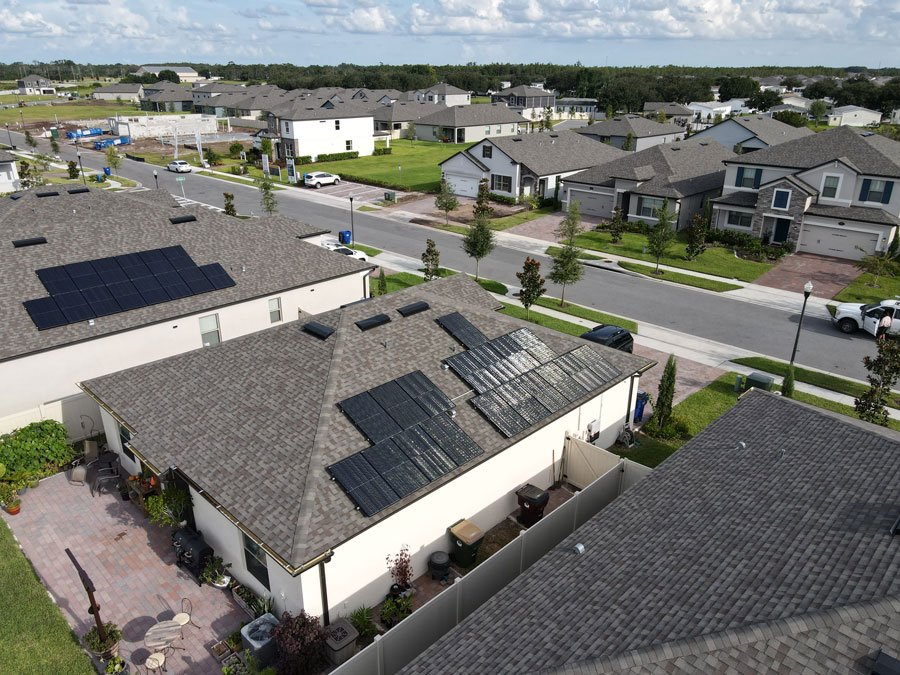This entry is to address the many questions I often get about solar panel installations, as well as the solar panels themselves, which is something that most new customers don’t usually have a firm grasp of yet.
So, let’s start with the solar panels. There are two primary classes of solar panels-Monocrystalline and Polycrystalline. Both have their pros and cons which a solar customer should definitely understand. Polycrystalline panels are designed to generate power, and very efficiently, in applications where the quality of sunlight may not be optimal–for instance, in higher latitudes. If I lived in Buffalo or Berlin, I would definitely want a polycrystalline panel as they will generate more power with the less intense sunlight available than its counterpart. However, when you expose a polycrystalline panel to high heat and high humidity as we have here in central Florida, the power drop-off is significant. Monocrystalline panels are designed for Florida’s high heat and high humidity and will perform significantly better. That being said, I still get challenged by prospective customers on panel selection and it’s understandable when you consider how hard it is to find accurate information on the web. A customer will Google “Brand X” of polycrystalline panels and say “But these panels have a 4.8-star rating? I want these.” Again, I look for high reviews when I’m selecting even a small soap dish. The problem with the reviews is: Where were the panels installed/where does the customer live? Most polycrystalline panels will have great reviews in Madison Wisconsin but what would the reviews look like if that same customer lived in West Palm? Maybe a 2.8?
Since many people assume a panel is a panel, know the difference. It could result in considerably less power output and therefore a longer pay off of your investment. And one other concept regarding power output-P.I.D. PID? It sounds like a disease? It is very similar to a disease, for solar panels at least. P.I.D. stands for Performance Induced Degradation. Over time, free electrons move in between photo cells which short them out and cause them to lose their ability to produce maximum power. Most quality panels will only loose about .5% per year, which is about a 12.5% loss at the 25-year mark. Most quality panels are under warranty and will be replaced if their output is less than the above guidelines. Panels that are not PID free or at least PID resistant are not panels I would recommend.
So, how are the solar panels installed? Most solar installers here in Florida use a “conduit mount system”. This means a low-profile grid of aluminum rails (that won’t rust) are attached through your roof and into the trusses and the panels are secured onto the conduit frame. The conduit/rail systems are pretty slick. When installed properly leaks are basically engineered out (most reputable companies will give you a life time warranty on any roof leaks associated with the install) and the panels/system are engineered to handle 120-130mph winds, which is where most roofs peak out at anyway. One of the “cool” benefits of this installation method is that every bit of roof that is under a panel is now in the shade. This reduces the amount of radiant heat passing through the roof, into the attic, etc., which will have a beneficial effect on keeping your home cooler as the part of roof that is getting the most sun (where the panels are installed) is now in the shade. Most quality panels these days have an impact resistance equivalence of baseball-size plus hail stones so this concern is virtually eliminated with quality engineering.
Panel location/placement: The orientation of the roof is something that cannot be changed with a solar install. What we have to work with, is all we have to work with. Roof facings that face south, west, east, or a variation thereof, are ideal whereas, facings north, northeast, northwest, are not worth putting panels on as they will generate so little power they cannot pay for the investment. At risk of stating the obvious, many inquiries on solar cannot proceed just due to this concept-If you have little roof surface facing in an optimum direction, going solar may not be worth it. If you have trees/shading issues that cannot be economically resolved, this could kill a solar project on the spot. Certain jurisdictions here in Orlando have local ordinances that forbid tree removal and even pruning. Bottom line is, you can’t change your roof orientation and you may not be able to change the shading issues, particularly when the shading is coming from your neighbor’s trees, which happens all the time.
A quality solar panel installation company will provide you with a solar panel installation diagram which usually represents the maximum number of panels that can be placed on the roof in production areas that are warranted. This serves as a “solar panel installation guide” since your power requirements may not necessitate all the panels the roof could accommodate. You may be able to eliminate panels for aesthetic reasons if the number of panels on the solar panel installation diagram exceeds the number of panels actually required. Solar panel installation cost is, of course, contingent on these as well as other variables.
I would encourage a prospective customer to check solar panel installation jobs near you, performed by the company you are considering. If you are seeing conduit runs across the top of the roof from one solar array to the other you may want to reconsider? A quality installation should have little or no visible conduit. All wiring should go through the roof and attic and out under the eaves.
These photos offer an example of what a quality installation should look like. Even installed on the front of a home, the panels are aesthetically pleasing.

